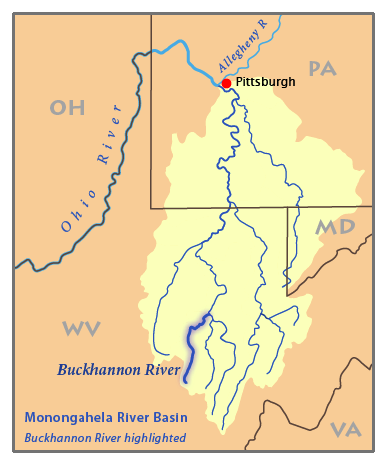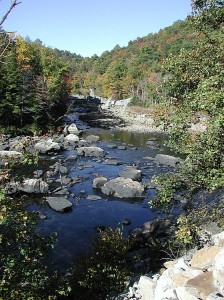Local News from Station WDTV, News 5, Elkins, WV, July 20, 2023
MILL CREEK, W.Va (WDTV) – Officials say a violent rain storm on Saturday, July 15th, led to more than 4,000 tons of clean coal being spilled into the Buckhannon River.
The West Virginia Department of Environmental Protection, or DEP, says the storm damaged control structures at the Carter Roag facility in Randolph County and led to about 4,500 tons of clean coal being spilled.
DEP officials say most of the spilled clean coal made it into the left fork of the Buckhannon River and into the Tygart Valley River because of the area receiving nearly 2.5 inches of rain in an hour.
The DEP was notified of the spill Sunday night, and officials say crews were onsite the next morning.
Officials say the company made significant repairs by Monday morning. As remediation work continues, the DEP is overseeing the project. There have not been any visible impacts to aquatic life, including fish, observed since the spill occurred, DEP officials say.
The DEP says preliminary readings indicate the water chemistry in the streams remains mostly unaffected. The DEP also says they have issued three Notices of Violation to the company responsible for the spillage.
Although the company is not actively mining coal, officials say it operates a prep plant that is currently processing the last of recently mined coal. Once that is complete, officials say the plant will not be operational, leaving the remaining coal stockpiles to be shipped out by rail. The company will then begin cleaning up and reclaiming the area around the prep plant.
Because of the amount of coal fines spilled and how they were distributed along the banks of the affected streams, DEP officials say it is likely that future rain events will cause the material to continue washing downstream.



{ 1 comment… read it below or add one }
How Dangerous Is the Coal-Washing Chemical Spilled in West Virginia?
>>> From the Article by David Biello, Scientific American, January 10, 2014
Do not drink the water, but it’s also not time to panic!
Water is a universal solvent, capable of dissolving most elements on Earth. But it fails when it comes to completely cleaning coal. That’s where 4-methylcyclohexane methanol, MCHM for short, comes in.
MCHM is used in washing coal, helping separate the burnable fossil fuel from the unburnable rock and dirt and other impurities. In the taxonomy of chemistry, it’s an alcohol, which means a molecule with a hydrogen atom and an oxygen atom bound to one of its carbon atoms. And despite the methanol in its name, it not the same compound as the “wood alcohol” most famously found in moonshine and known to cause headaches, blindness and even death.
Many West Virginians received a disastrous introduction to MCMH this week, thanks to a spill of thousands of liters of the industrial chemical into the Elk River, which serves as the water supply for the counties in the middle of the state. Some 300,000 people in the region have been advised not to drink the water, for now.
Officials know little about the chemical at this point. Because it is not used in consumer products but rather in industrial settings, its toxicity and other effects on humans are largely unknown. “It’s a little bit of an obscure compound,” says chemist Rolf Halden of the Center for Environmental Security at the Biodesign Institute at Arizona State University.
That said, some of MCMH’s basic properties are known, both helpful and harmful to humans.
What is it and what is it used for? ~ Chemists classify MCMH as an organic solvent. That means it dissolves other compounds and is made from chains of carbon bonded together. In this case it is used to separate coal from non-coal components in mined material. It is one of a long list of liquid chemicals used to wash coal, and such chemical or physical washes are commonly applied to most mined materials, whether minerals or ores. “It doesn’t have a lot of obvious other uses,” Halden says. “It’s not a chemical you find in consumer compounds. That means it’s a chemical that has not seen a lot of safety reviews.” That situation is likely to change as a result of this incident.
How dangerous is it? ~ MCMH should not be swallowed and may readily cause skin and eye irritation but it is not known to pose major risks to human health and safety. That said, the colorless liquid chemical has not been studied extensively—its effects on cancer or inducing mutations in DNA is unknown. It freezes at 0 degree Celsius and it evaporates slowly, but not as easily as, say, gasoline. It smells like alcohol, according to safety reviews, but some of those exposed in West Virginia described it as smelling more like licorice. Its solubility in water is “appreciable,” according to one of its Material Safety Data Sheet, information required by regulation for any chemical in industrial use.
MCMH can burn but only when concentrated and at relatively high temperatures above 112 degrees Celsius. It is not explosive. It is not corrosive (although it could cause problems for things like rubber seals in the water system). MCMH also adheres to some of the compounds in soil. It is poisonous but only at relatively large doses; in rats it killed half of the animals tested at concentrations above 825 milligrams per kilogram of body weight. Given that MCMH has spilled into a river this time, it might be more relevant that it killed half of fathead minnows exposed at concentrations of roughly 57 milligrams per liter of water.
The chemical has a half-life (meaning half of it will have broken down into other elements in this amount of time) of roughly two weeks in water, a month in soil and, if it gets into the muck at the bottom of the river, 140 days in sediments. Microbes and the slow workings of natural chemistry help with that. Its half-life is less than a day in air, quickly broken down by sunlight.
Nonetheless, as Halden says “exposure should be avoided because the health effects are a bit uncertain. You should never be exposed to an industrial chemical unless there’s a good reason.”
Is the water safe? ~ The water contaminated by the spill should not be used for drinking or showering, but is fine to use for things like flushing the toilet. The idea is to avoid direct contact with the contaminated water, and to avoid ingesting it or inhaling it. “We may not have the information to know whether it’s really safe for the general population,” including children, the elderly, the sick or pregnant women, says chemist Richard Sachleben, who works in pharmaceutical research and development. Shutting down the region’s water supply was an “appropriate level of precaution,” he adds.
Is it methanol? ~ No. Chemical nomenclature can be confusing. “What it has in common with methanol is that they are both alcohols,” Sachleben says. MCMH (C8H16O) is a much bigger molecule than methanol (with eight carbon atoms at its center versus the one in CH3OH) and breaks down in different ways.
Can it be cleaned up? ~ Yes, but it might make more sense to stop the spill, contain it and then wait for nature to take its course. Other alternatives include using some kind of a boom to contain the spill in the Elk River and then pump as much of the chemical as possible out of the waterway. “The rest is going to have to wash away down the river,” Sachleben says.
How dangerous is this spill? ~ Exposure to the slurry of water and other chemicals formed after coal is washed would be more dangerous to human health than exposure to MCMH—and there have been numerous coal slurry floods and spills in West Virginia and U.S. history. That slurry is made far more toxic by the heavy metals and other dangerous elements leached from the coal itself. It also is far less dangerous than some other industrial solvents (PCBs for example), byproducts (such as dioxin) and other liquid industrial spills (fly ash slurries).
In fact, Americans typically are exposed to other industrial chemicals every day that pose far more risk, such as the gasoline pumped into our vehicles. Gasoline is flammable, evaporates easily and contains compounds known to cause cancer. “A fair assessment is to compare [an MCMH spill] to a spill of gasoline,” Halden says. “It’s not super dangerous but it’s not harmless and it needs to be dealt with. It shouldn’t be a long-term concern for people.”
SOURCE: https://www.scientificamerican.com/article/how-dangerous-is-the-chemical-spilled-in-west-virginia/